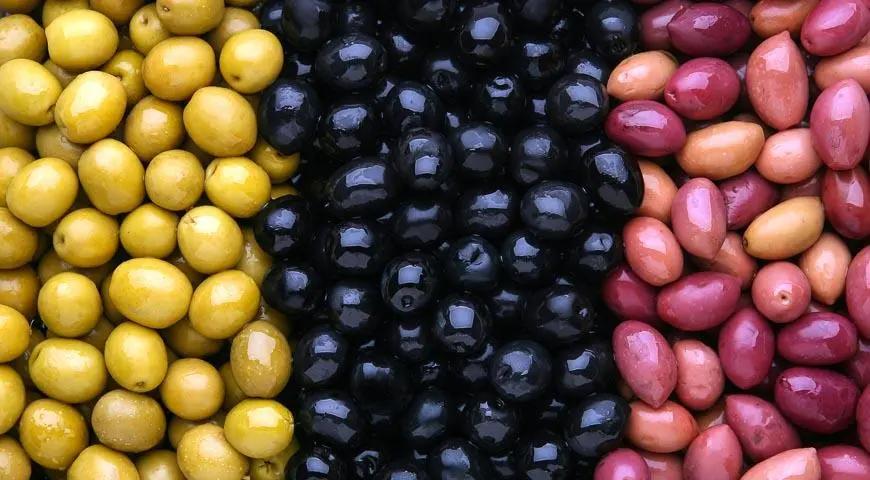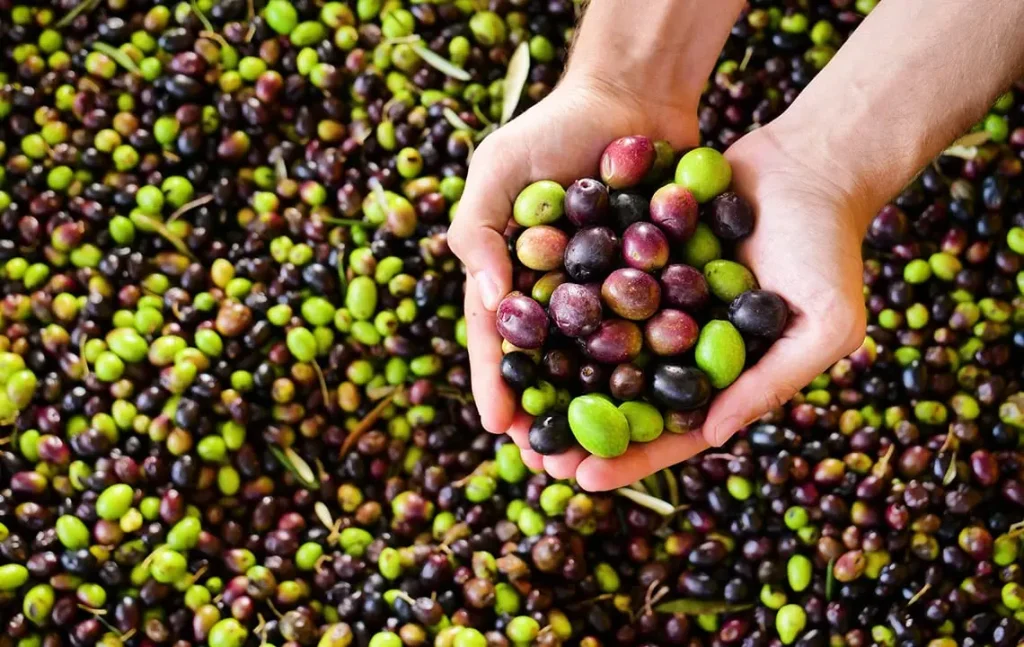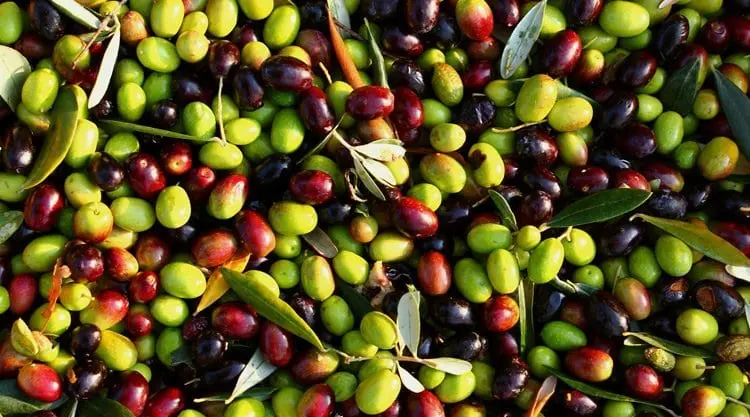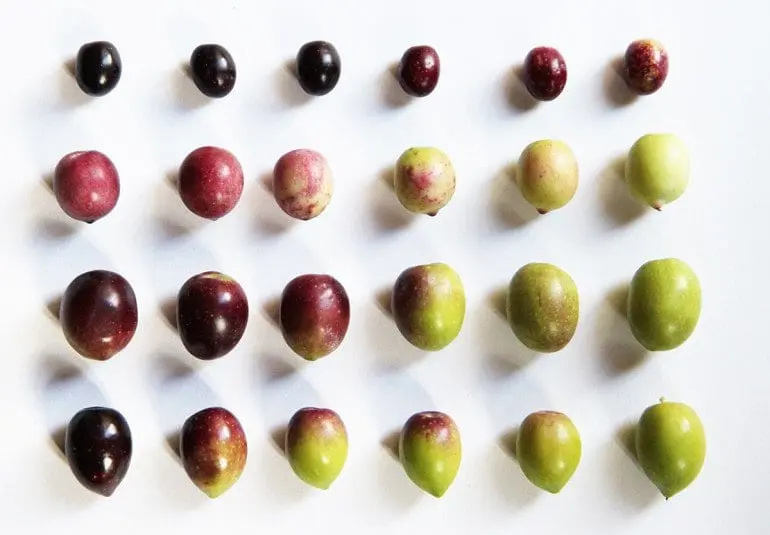Contents
There are several myths about black and green olives.
- MYTH 1. Black and green berries are the fruits of related but different olive trees.
- MYTH 2. Black and green olives are the fruits of the same tree but with different degrees of ripeness. People consider unripe ones to be green, black ones – ripe.
I must say that there are more fans of the second myth, and it is much closer to reality. But this is still a myth. It is absolutely true only in the first part: black and green olives are fruits of the olive tree – European olives (Olea Europea), or, as it is also called, cultural. But if you buy a jar of black ones and think that these are ripe ones, you are most likely deeply mistaken in almost a hundred percent of cases, these people made from green olives.
Yes, these are the wonders of food technology. Until recently, the world did not know that such products exist, they were made in the old grandfather’s way, and green was green, and black was black. But when producers decided to make them a global product, food technology engineers changed their production approach. As a result, they began to make them quickly and at a lower cost. Why so? More details on this later.
Green ripe olives
These should not be considered immature. Their color ranges from yellow-green to straw, and inside they are white. The olives themselves are dense; they contain fewer oils. People can store them longer and process them using traditional and modern chemical methods.
Berries that are beginning to change color, are usually turning reddish-brown. Their flesh is still white, but the “berries” themselves are no longer so tough. People process it using both old and new methods, using alkali.

Naturally black ripe
Olives naturally blackened on the wood. They are the most expensive and high quality; it is better to collect them by hand and before the cold weather. They are worse in storing, more easily spoiled. The flesh of the fruit is already dark. It is better to process them using traditional methods – without chemicals. You can make products in Greek style by drying them.
Chemistry into life
Have you ever wondered why people don’t sell fresh olives? Can’t they bring it to the USA? Why can bananas come from the other side of the world, but olives can’t? The point is different: fresh berries are practically inedible; they contain a very bitter and useful substance, oleuropein. To remove it, people usually soak it in saltwater, often in seawater, and ferment for several months. This natural bitterness removal process took 3-6 months for black ones and 6 months for a year for green ones.
Modern large food manufacturers cannot make a product with such a long production cycle – they need everything to be done quickly and stored for a long time. Food scientists have figured out how to compress this time to a few days. To quickly wash out the bitterness, they began to add alkali (caustic soda) to the brine. As a result of this “chemical attack,” the production cycle shrank to several days.

These “geniuses” of food technology have learned how to make green berries black. If oxygen is still passing through the brine with green ones, the olives will turn black and look like natural black ones, which are traditionally more expensive.
Chemical methods
In general, almost all the green olives on our shelves in stores are made by an accelerated chemical method using alkali. This is unfortunate because berries, white or green, made traditionally, are fermented products – like our sauerkraut. Naturally, they are incomparably better and more useful than leached ones. They have a more elegant taste; they are juicier, their pulp does not look like a dry sponge soaked in brine, like leached ones. And finally, they are much healthier – they retain more active substances for which olives are so famous and have a beneficial effect on health.
Key questions
I think every olive lover now has two key questions. First, how to distinguish black ones from natural black olives when buying? And the second: how to distinguish leached olives from those made traditionally – without chemicals?
Let’s start with the second question; the answer to it seems very simple. If to add caustic soda, it should be present in the label’s composition. Logical, but wrong. The typical composition of these green ones is “pitted olives”, water, salt, acidity regulator lactic acid, antioxidant citric acid. And no food additive E524 (caustic soda), or, sodium hydroxide. Why is this substance absent in the composition when it is used in production? Lye quickly penetrates the olives, killing the bitterness, but then it is washed off, and no mention of it remains on the label. This is officially allowed.
Distinguish the olives
Unfortunately, the current labeling system does not help us distinguish such accelerated olives from traditional olives. This certain way to know that is to buy olives from a manufacturer who specifically indicates the method of making olives on the label. But this does not often happen, even if producers made them in the old grandfather’s way. Therefore, we can only distinguish them by indirect signs.

- Rule 1. Accelerated olives are usually cheaper and are more often in iron cans (unfortunately, there are exceptions to this rule).
- Rule 2. Artificial black ones are different from mature ones, and you may see them not opening the can. They always contain iron gluconate (additive E 579) – this is a chemical for fixing black color. Without it, the olives will turn pale. These are very black and often shiny. This is an unnatural color.
- Rule 3. Natural ripe ones are duller, brownish, and unevenly colored: a barrel facing the sun is brighter and darker – it ripens faster and hiding in the shade – paler.
- Rule 4. Traditional olives are not only black and green but also pinkish, slightly purple, or brownish. These are olives of medium ripeness.
- Rule 5. Another type of traditional one without chemistry has a name Greek. They dry and somewhat get some wrinkles. They are not usually provided in brine (like all those listed above). Producers are simply pouring it into cans, often with a small addition of oil. Their taste is slightly more bitter.
Black and artificial olives
Most of the artificially blackened olives are made in Spain; they are called Spanish-style olives (in the United States, this style is called Californian). But be careful: in other Mediterranean countries, people make such products as well. However, people are still making olives using traditional methods there. Fortunately, such black olives can always be distinguished from natural black olives made traditionally. This is even though some country’s labeling requirements are traditionally unfriendly to the consumer and do not force manufacturers to disclose how they are made. It’s just that they always have a “keyword” that allows you to distinguish pseudo-olives from real black ones, ripened to such a color on the tree. And this keyword is iron gluconate or E579. It is a color stabilizer that prevents oxidized olives from turning green again.
Here is the typical composition of these olives: olives, water, salt, ferrous gluconate. Producers usually add lactic or citric acid, vinegar, and some other acidifiers and indicate it in the composition. Mediterranean producers can call such products olives, black olives, largely selected olives. But, no matter what tricks producers use, if the composition contains iron gluconate, then these are blackened olives. This means that people collected them green, treated with alkali, “dyed” with oxygen, and their color got stabilized with this substance.

Good to know
Besides, artificially blackened olives are easy to distinguish, even if they are sold by weight, and the composition is not specified anywhere. They are very black, often even shiny. This is an unnatural color. Natural mature black olives are dull and brownish. People often color it unevenly: the barrel facing the sun is brighter and darker – it ripens faster, and the one hiding in the shade is paler. These are “flaws” in appearance, indicating the naturalness of olives. One can clearly see them in glass jars or when they are sold in bulk.
Traditional methods
Products made using traditional methods (no chemicals) can be black or green and black or green and pinkish, slightly purple, or brownish. These are either medium-ripeness or special varieties of olives that darken moderately. For example, the Greek olives of Kalamata are purple rather than black.
Turkish style olives
There is another type of traditional olives during the production of which producers do not use chemicals and even brine. These are Turkish style; they are not sold in brine (like all of the above); people pour them into cans or pack them in plastic bags. Often people add a little oil to them. Outwardly, they are very different from other types – their fruits are somewhat shriveled, dried. Their taste is also different – they are slightly more bitter, but many like it.
Knowledge is power

“In the Mediterranean countries, almost everywhere where olives grow, I have repeatedly observed one interesting dietary habit – some people swallow several olives with the seeds while eating,” says Anatoly Gendlin, an expert on national food cultures. – There is a popular belief that it is beneficial and even protects against cancer. However, the local doctors do not confirm the usefulness of this.
Digestion of the bones
Some argue that bones during digestion and release nutrients. I tried to split the olives’ pits and made sure that it is solid, and, most likely, it is too tough for the digestive enzymes. On the other hand, olives can contain useful substances in the kernel – the contents of almost any seeds, be they nuts or seeds, are very rich in them. Therefore, maybe it is better to chop olive pits like nuts? Fortunately, for most, bones are harmless. Still, in people with adhesions, constipation, and sluggish intestines, they can become that “growth point” around which a bezoar forms – a foreign body in the stomach and intestines. Sometimes this leads to problems with digestion, up to intestinal obstruction.
And pay attention to the shape of the seeds; in some varieties of olives, they have sharp ends and can hurt the mucous membrane. By the way, the Mediterranean diet is very healthy and therefore protects against cancer and other diseases in and of itself.
Some nutritionists believe that the Mediterranean diet is not entirely suitable for residents of cold countries, including Russia. The best option for them is the Norwegian diet.
Why olives are useful
The oil from black and green olives forms the basis of the Mediterranean diet, that many people recognize to be the healthiest in the world. Olives contain over 100 substances, not all of them have been studied yet.
- A unique set of three phenolic substances: simple phenols (hydroxytyrosol, tyrosol); oleuropein, aglycones; lignans.
- Squalene – protects against the development of skin cancer.
- Monounsaturated fats, vitamin E, help lower bad cholesterol and increase good cholesterol, protect blood vessels from atherosclerosis.
- Oleokanthal – anti-inflammatory and analgesic effect.
- Oleic acid – prevents the development of breast cancer.
Gift from above

People have always associated the olive tree with something divine. The ancient Greeks believed that they owe the olive to the goddess Athena, so the olive branch personified wisdom and fertility for them. The Egyptians attributed the olive to the goddess Isis and were sure that this tree was a symbol of justice. Christians believe that a dove with an olive branch in its beak brought the message of a truce between God and people after the Flood. Perhaps this respect for olive trees is due to their longevity. The olive grows very slowly, and some of the trees are over a thousand years old. This is probably why many people have a belief that the olive never dies and can live forever.
Some specific features
The fruits of the “eternal” tree may not be alike at all. Some varieties are comparable in size to cherries, while others are more like plums. The color changes during maturation. Green olives acquire a pinkish-brown hue over time, and when they finally ripen, they turn black.
But all varieties of black and green olives have one thing in common – you should not eat them fresh. The fruits just plucked from the tree are very tough, and if you still manage to bite off a small piece, an indescribable bitterness awaits you. Therefore, to get an exquisite snack, black and green olives need to soak for a long time, and then people salt or pickle it. At the same time, salted fruits are tougher than pickled ones.
In order not to grow old
The legendary Avicenna considered olives to be a cure for almost all diseases. The famous doctor was not so wrong, because these fruits are beneficial for our body. Black and green olives contain a lot of B vitamins (the main helpers of our brain and nervous system), vitamin A (needed for sharp vision), vitamin D (necessary for strong bones and healthy teeth), ascorbic acid (strengthens the immune system), vitamin E (protects against harmful effects of the environment, prevents cardiovascular diseases, premature aging and malignant tumors).
Still, the main wealth of olives is oil. Its content in fruits can range from 50 to 80%. Moreover, the riper the olives, the more oil they contain.
Olive oil is a truly unique product. It contains a huge amount of unsaturated fatty acids. They are necessary to lower the level of harmful cholesterol in the blood, protecting our cardiovascular system, and preventing atherosclerosis. The oil contained in olives improves digestion and awakens the appetite. This is why olives are often served as a snack before dinner. And if you eat 10 olives daily, you can protect yourself from the development of gastritis and stomach ulcers.
Beneficial effect
Berries help neutralize any substances that are toxic to the body. Therefore, they are considered an ideal addition to many alcoholic cocktails. Berries perfectly set off the drink’s taste and protect against morning sickness after a friendly party.
For a long time, people believed that black and green olives increase masculine strength. Whether this is really so is still unknown, but the inhabitants of the Mediterranean countries, where berries are present in the daily menu, are really famous for their hot temperament.
Caliber matters

You can find berries with anchovy, lemon, pepper, pickles, and other goodies on the shelves. But it is not customary to stuff olives. Their taste is already quite rich and should not be “spoiled” by various additives. The only “manipulation” allowed with berries is removing the bone. However, gourmets are sure that this operation only spoils the quality and taste of the product.
Picking the caliber of olives
If you plan to put your favorite jar of olives in your bag, be sure to pay attention to their caliber. The indication is provided by numbers written with a fraction, for example, 70/90, 140/160, or 300/220. These numbers represent the number of fruits per kilogram of dry weight. Therefore, the larger the caliber number, the finer the olives. The inscription 240/260 says that there are no less than 240 and no more than 260 olives per kilogram. Fruits closed in a jar should be approximately the same shape and size – this indicates the quality of the product.
And of course, the jar should not have deformation, there should be no traces of rust or other damage on it.
Interesting
Scientists have found out why women in the Mediterranean are less likely to get breast cancer. The clue is oleic acid: being the main ingredient in olive oil, it is found in most local cuisine. Studies carried out at the Northwestern University of Chicago show that this substance reduces the risk of malignant tumors and increases the effectiveness of treatment if it does appear.
Scientists have also found that the risk of heart attack is reduced if most of the patient’s calories come from oil rather than other foods. The study involved 342 people, of whom 171 had already survived one myocardial infarction.
And according to other studies, oil can help your sore head no worse than the pharmacy drugs since the substances found in it correspond in effect to the ibuprofen contained in pain medications.

By the way
Australian researchers have found that the more people consume olive oil, the fewer wrinkles they have. Oleic acid, which is part of olives and extra virgin olive oil, penetrates skin cells’ membranes, filling them, which makes fine lines and wrinkles less noticeable. To include as many olives in your daily diet as possible, use olive oil for cooking, add olives to pasta sauce and salads – or eat them whole.
Recipes from olives
Snowballs from olives
1 can of pitted olives, 50 g of shelled walnuts, 100 g of hard cheese, 1-2 cloves of garlic, 3-4 tbsp—tablespoons of mayonnaise, 100 g of crab sticks.
Place a piece of walnut in each olive. Prepare the mixture: grate the cheese on a fine grater, crush the garlic, add mayonnaise, mix everything.
Grate crab sticks on a fine grater. Dip the olives in the cheese-mayonnaise mixture and sprinkle with crab sticks.
Green salad with meat and beans
Salad – 100 g. Boiled meat (beef, pork) – 200 g. Boiled beans – 100 g. Onions – 100 g. Vegetable oil – 50 g. Garlic – 50 g. Pitted olives. Salt. Hot pepper.
Chop the onion finely and save it in vegetable oil. Cut the meat into cubes. Combine green salad, beans, onion, meat, chopped into strips, add pepper, chopped garlic, and salt to taste. Decorate the salad with olives.
More health benefits of olives are provided in this video below:










